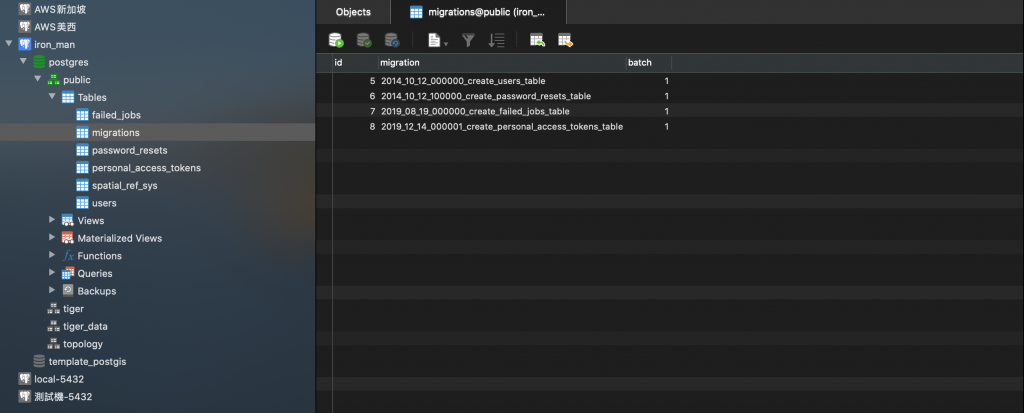Docker及Laravel為以後每個專案都會用到的搭配,所以這種時候就將它做成一個類似模板的環境並將他上傳到Github,如果以後有新專案要做的話直接clone下來就可以了,記得使用composer install、新增.env檔,利用指令啟動。
docker-compose up -d
Docker啟動後的資料夾分佈會長這樣
.
├── backend
│ ├── laravel
│ │ ├── README.md
│ │ ├── app
│ │ ├── artisan
│ │ ├── bootstrap
│ │ ├── composer.json
│ │ ├── composer.lock
│ │ ├── config
│ │ ├── database
│ │ ├── package.json
│ │ ├── phpunit.xml
│ │ ├── public
│ │ ├── resources
│ │ ├── routes
│ │ ├── server.php
│ │ ├── storage
│ │ ├── tests
│ │ ├── vendor
│ │ └── webpack.mix.js
│ ├── nginx
│ │ └── default.conf
│ └── postgresql
│ ├── PG_VERSION
│ ├── base
│ ├── global
│ ├── pg_commit_ts
│ ├── pg_dynshmem
│ ├── pg_hba.conf
│ ├── pg_ident.conf
│ ├── pg_logical
│ ├── pg_multixact
│ ├── pg_notify
│ ├── pg_replslot
│ ├── pg_serial
│ ├── pg_snapshots
│ ├── pg_stat
│ ├── pg_stat_tmp
│ ├── pg_subtrans
│ ├── pg_tblspc
│ ├── pg_twophase
│ ├── pg_wal
│ ├── pg_xact
│ ├── postgresql.auto.conf
│ ├── postgresql.conf
│ ├── postmaster.opts
│ └── postmaster.pid
└── docker-compose.yaml
nginx的default.conf內容有變更要注意,root會指向laravel的public資料夾
server {
listen 80;
index index.php index.html;
server_name localhost;
error_log /var/log/nginx/error.log;
access_log /var/log/nginx/access.log;
root /var/www/laravel/public;
location / {
try_files $uri $uri/ /index.php?$query_string;
}
location ~ \.php$ {
try_files $uri =404;
fastcgi_split_path_info ^(.+\.php)(/.+)$;
fastcgi_pass php:9000;
fastcgi_index index.php;
include fastcgi_params;
fastcgi_param SCRIPT_FILENAME $document_root$fastcgi_script_name;
fastcgi_param PATH_INFO $fastcgi_path_info;
}
}
docker-compose裡的nginx與php掛載資料夾也要注意有變更
version: '3'
networks:
laravel:
services:
nginx:
image: nginx:stable-alpine
container_name: nginx
ports:
- "8080:80"
volumes:
- ./backend/laravel:/var/www/laravel
- ./backend/nginx/default.conf:/etc/nginx/conf.d/default.conf
depends_on:
- php
- postgresql
networks:
- laravel
php:
image: kurt6783/iron_man
container_name: php
working_dir: /var/www/laravel
ports:
- "9000:9000"
volumes:
- ./backend/laravel:/var/www/laravel
networks:
- laravel
postgresql:
image: mdillon/postgis:10
container_name: postgresql
tty: true
ports:
- "5432:5432"
environment:
- POSTGRES_PASSWORD=1234
volumes:
- ./backend/postgresql:/var/lib/postgresql/data
networks:
- laravel
這樣完整的專案環境就算建置好了,總算要進入今天的正題,Laravel - migration。
先移動至laravel資料夾,之後的操作幾乎都是在這層操作
cd backend/laravel
可以看到有database/migrations這個資料夾,裡面會有四個已經建立好的檔案,接著試試看下指令
php artisan migrate
接著就會看到系統以迅雷不及掩耳的速度把table都建立好了,可以用Navicate來檢查一下
可以看到每個migration裡面都有up&down,up內的事情會在migrate時執行,down內的事情會在rollback時執行
php artisan migrate:rollback
migration是一層一層疊上去的,疊的順序可以migrations這個table裡面的batch來得知,當使用rollback指令時會將最上方的一層資料移除掉,如果想要將全部的table都移除,可以使用reset
php artisan migrate:reset
但是要特別注意,使用rollback或是reset時,table裡的資料會被移除而且無法救回,這兩個指令要小心使用。
還有一個比較特別的指令:seed,先打開database/seeders/DatabaseSeeder.php這個檔案,會看到有一行code被註解掉了,將此註解打開
\App\Models\User::factory(10)->create();
如果在使用migrate時搭配指令就會依照需求創建基本資料
php artisan migrate --seed
創建資料的格式會在database/factories,與其model對應的factory裡被定義。
Migration的操作差不多就這幾項,謝謝觀看的各位,請記得按讚分享開啟小鈴鐺,你的支持會讓按讚數+1。
